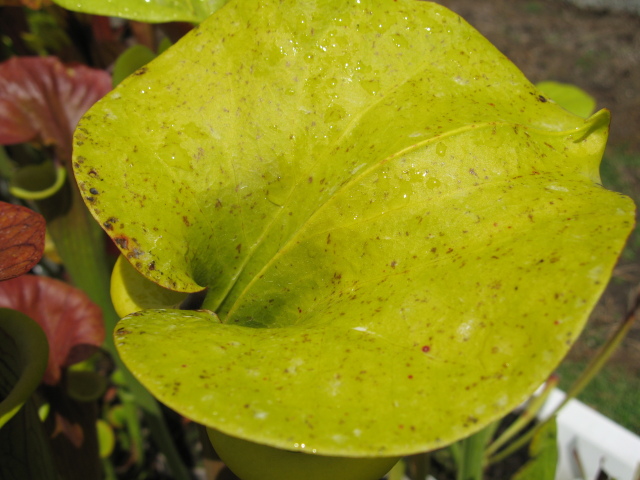Question
 IMG_3213.JPG
IMG_3213.JPG
Conditions
1) The species of carnivorous plant you're growing. S-Flava
2) A concise description of a single issue.
Situation:
S Flava Plants started developing small black spots on the pitcher tubes & lids and even on new spouting pitcher.(See attached photos) This just started happening in a day or two after rain. Spots seem to be permanent damage not anything you could wipe off with a Q-tip.
Question:Any idea what these spots are or what is happen? These spots are ugly and seems to be spreading only on flava.
3) The type of lighting, water and soil you're using.
Full direct sunlight, 5 to 8 hours daily. Water is Merlin RO 750gal system; soil is 2-pt canadian spagnum, 1 pt perlite, 1-pt silica sand.
4) Your location to assess climate issues (e.g. Charlotte, North Carolina).
Coastal Southern California, Near San Diego CA.
5) A CLEAR photograph of your plant. (Not necessary, but extremely helpful. No blurry plant photos, please. The plant, not the background, needs to be in focus.)
AnswerThere's nothing wrong with the plant per se. It's a form of rust spots, a type of fungus that is very common, very benign and often unavoidable. Some Sarracenia are prone to it. Others are not. The spots occur from heavy nectar secretion throughout the hood and rim of the pitcher. As the temperature increases, the nectar dries up. Fungus then feast on the dried nectar and leaves a red spot on the leaf. The fungus is extremely benign and doesn't harm the plant in any way other than cosmetically. Once the spots occur, they remain permanently, so there's no way to reverse it. It also occurs mostly on older pitchers, so as the season progresses, it'll show up on the older pitchers. Younger pitchers tend to be free of rust spots until they get a bit older, about 2 months.
It's possible to prevent the rust spots by spraying your plants with a sulfur fungicide, but you'll need to do it weekly, and it's not always a guarantee since the sulfur will wash off in a few days. Given your location, you're seeing it a bit earlier than we do in Oregon. Typically we see it in July when our weather really heats up.
While it may be unsightly, it's a very normal occurrence when some plats produce lots of nectar.
Good growing!
Jacob Farin






